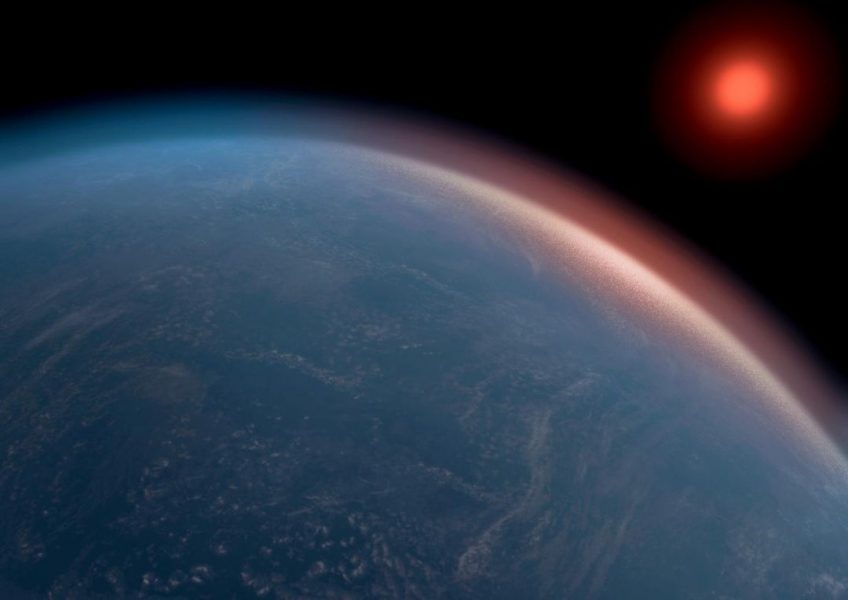For centuries, humans have looked up at the stars and asked, “Are we alone in the universe?” That age-old question may finally be closer to an answer than ever before. In a discovery that has sent shockwaves through the scientific community, astronomers using NASA’s James Webb Space Telescope have detected what may be the strongest evidence yet of alien planet life — not in our solar system, but 124 light-years away, on a distant world known as K2-18b.
This ocean-covered exoplanet, orbiting a dim red dwarf star in the constellation Leo, has revealed the chemical fingerprints of life-associated gases in its atmosphere — molecules that, on Earth, are produced exclusively by living organisms like marine algae.
While scientists are urging caution, emphasizing that this is not a direct discovery of life, the findings mark a watershed moment. It’s the first time biosignatures of this kind — specifically dimethyl sulfide (DMS) and dimethyl disulfide (DMDS) — have been detected with such clarity beyond our solar system.
“This is a transformational moment in the search for life,” says Professor Nikku Madhusudhan of the University of Cambridge, lead author of the study. “We may be witnessing the first signs of a living sky.”
Welcome to the dawn of observational astrobiology, where science fiction edges closer to science fact.
What Is K2-18b and Why It Matters
Nestled in the “Goldilocks zone” — the region around a star where conditions might just be right for liquid water to exist — K2-18b has long intrigued scientists. Discovered in 2015, this exoplanet lies about 124 light-years from Earth in the constellation Leo, and it orbits a cool red dwarf star far smaller and dimmer than our Sun.
But this isn’t your average Earth-like planet. K2-18b is a “sub-Neptune”, a class of planet that is larger than Earth but smaller than Neptune — specifically, it’s 2.6 times the diameter of Earth and 8.6 times more massive. Its unusual characteristics have led researchers to propose that it might belong to a new class of world altogether: the Hycean planet.
What’s a Hycean World?
The term Hycean combines “hydrogen” and “ocean,” and it refers to a theorized type of exoplanet that features:
- A hydrogen-rich atmosphere, and
- A deep global ocean of liquid water
According to Madhusudhan and his team, if Hycean worlds like K2-18b exist, they could be excellent candidates for hosting microbial life — especially the kind that once thrived in Earth’s earliest oceans. These planets could harbor warmer waters, more energy for life to flourish, and atmospheres easier to scan for biosignatures due to their size and composition.
K2-18b’s position in its star’s habitable zone — coupled with its atmospheric chemistry — makes it one of the most promising exoplanets ever found for studying signs of alien life.
But what exactly did the James Webb Space Telescope see that has the scientific world buzzing? Let’s break down the biosignature discovery in the next section.
The Evidence: What Scientists Discovered About Alien Planet Life
In what may be the most significant clue to alien planet life yet, scientists studying K2-18b have detected two sulfur-based molecules — dimethyl sulfide (DMS) and dimethyl disulfide (DMDS) — in the planet’s atmosphere. These gases are notable because, on Earth, they are produced exclusively by biological activity, primarily by marine microorganisms like phytoplankton.
How the James Webb Telescope Made the Discovery
Using the transit method, astronomers observed K2-18b as it passed in front of its host star. As starlight filtered through the planet’s atmosphere, the James Webb Space Telescope (JWST) analyzed the spectrum of light to determine which molecules were present.
Earlier observations had already revealed methane and carbon dioxide, key carbon-based molecules. But with JWST’s new mid-infrared instruments, the team found much stronger signals of DMS and DMDS — signatures that were previously only hinted at.
At a confidence level of 99.7%, the presence of at least one of these gases appears statistically robust — though researchers emphasize that confirmation through additional observations is crucial.
“Based on our current understanding, this concentration of DMS is thousands of times higher than on Earth and cannot be explained without biological activity,” said Professor Madhusudhan.
A Clue, Not a Conclusion
It’s important to note: this is not a discovery of actual alien organisms. Rather, it is the detection of a potential biosignature — a chemical trace that may indicate the presence of alien planet life.
Scientists, while excited, remain cautious. Some argue there could be abiotic (non-living) processes producing these molecules, though no such mechanisms are currently known for this environment.
Still, many experts agree this is the closest humanity has come to directly detecting life beyond Earth.
“This could be the tipping point,” Madhusudhan said. “We are now capable of probing alien planet life in ways that were science fiction just a decade ago.”
Alien Planet Life or Something Else?
While the detection of DMS and DMDS on K2-18b has electrified the scientific world, not everyone is ready to declare the presence of alien planet life just yet. The reason? These molecules, while biologically produced on Earth, could potentially have alternative, non-biological origins — and until those are ruled out, the claim remains a tantalizing possibility, not a proven fact.
The Scientific Caution
Professor Nikku Madhusudhan and his team, who led the study, have been transparent and careful not to overstate their findings. While the concentration of biosignature gases is unusually high — thousands of times stronger than on Earth — Madhusudhan stresses that multiple follow-up observations are needed to confirm their presence and eliminate the possibility of statistical noise or unknown chemical processes.
“It’s in no one’s interest to claim prematurely that we’ve detected life,” he told reporters. “We need to repeat the observations and rule out abiotic mechanisms.”
What Other Experts Say
Other astronomers and planetary scientists echo that caution:
- Stephen Schmidt of Johns Hopkins University called the discovery a “hint,” adding:“It’s not nothing — but we can’t conclude it’s habitable yet.”
- Laura Kreidberg, from the Max Planck Institute, said:“Extraordinary claims require extraordinary evidence. I’m not sure we’re at that level yet.”
- Some even challenge the habitability of K2-18b itself.
Raymond Pierrehumbert from Oxford argues the planet may be too hot due to its proximity to its red dwarf star, possibly hosting oceans of lava, not water.
Sara Seager from MIT also urged patience, reminding the community that earlier reports of water vapor on K2-18b turned out to be mistaken interpretations.
These responses underline a central principle of modern astrobiology: science thrives on skepticism, not hype. But even amid the healthy debate, one truth remains — we’ve never been closer to proving alien planet life might exist.
What’s Next in the Hunt for Alien Planet Life?
The recent discovery on K2-18b has ignited hope that we’re on the verge of a groundbreaking shift — from asking if alien planet life exists, to how soon we can prove it. But before that milestone is reached, scientists must double down on evidence, expand the search, and refine their tools.
Repeat Observations on the Horizon
Professor Madhusudhan’s team is already planning additional JWST observations, aiming to increase the statistical confidence of their findings from 99.7% to “five sigma” — a gold standard in scientific research that equates to a 1 in 3.5 million chance of being a fluke.
This will require just 16 to 24 more hours of telescope time, a relatively modest ask for what could be the most profound scientific confirmation in history.
Future Telescopes Joining the Mission
While the James Webb Space Telescope has been a game-changer, it’s just the beginning of a new generation of powerful observatories:
| 🌌 Telescope | 🧪 Purpose |
|---|---|
| Habitable Worlds Observatory (HWO) | Launching in the 2030s, designed to study Earth-sized exoplanets in habitable zones with unprecedented precision |
| Extremely Large Telescope (ELT) | A 39-meter ground-based telescope in Chile that will provide detailed views of exoplanet atmospheres |
| NASA’s Dragonfly (2034) | Will land on Titan, Saturn’s moon, to search for life-related chemistry in exotic, methane-rich environments |
These instruments will help scientists identify biosignatures on other worlds, rule out false positives, and compare atmospheric compositions across multiple planets.
A Broader Cosmic Shift
The current discovery is just one piece of a much larger puzzle. Researchers are actively scanning exoplanets, icy moons, and Martian soil for signs of life — from microbial fossils to complex organics.
“This is only the beginning,” said Madhusudhan. “The sky might not just be filled with stars and planets — it could be alive.”
Why This Discovery Could Change Everything
If future observations confirm what scientists are now seeing — that alien planet life exists on K2-18b or elsewhere — the implications will ripple far beyond astronomy. This moment could reshape our understanding of life, the universe, and ourselves.
A Cosmic Identity Shift
Throughout history, every major leap in space discovery has forced humanity to redefine its place in the cosmos. Once, we believed Earth was the center of everything. Then, we realized our planet is just one of many in a vast solar system — which itself is just one part of a galaxy among billions.
Now, we may be standing on the edge of the next evolution in thought: we’re not alone.
“The discovery of even simple life elsewhere would be a transformation of the human psyche,” says Prof. Madhusudhan. “It would change how we view ourselves, our relationships, and even dissolve the barriers that divide us.”
From Isolation to Interconnection
Far from being frightening, many scientists see the confirmation of alien planet life as something profoundly hopeful. Rather than isolated in a cold and empty cosmos, we’d be part of a greater, living universe — perhaps one where microbial life is common, and intelligent civilizations are just waiting to be discovered.
Dr. Robert Massey of the Royal Astronomical Society suggests this would continue a centuries-long trend of “reducing humanity’s specialness.” But as Prof. Michele Dougherty adds, it could also be spiritually uplifting — showing us that life is woven into the very fabric of the cosmos.
“Knowing we’re part of something larger will make us bigger,” Dougherty said. “It’s helping us find our place in the universe.”












